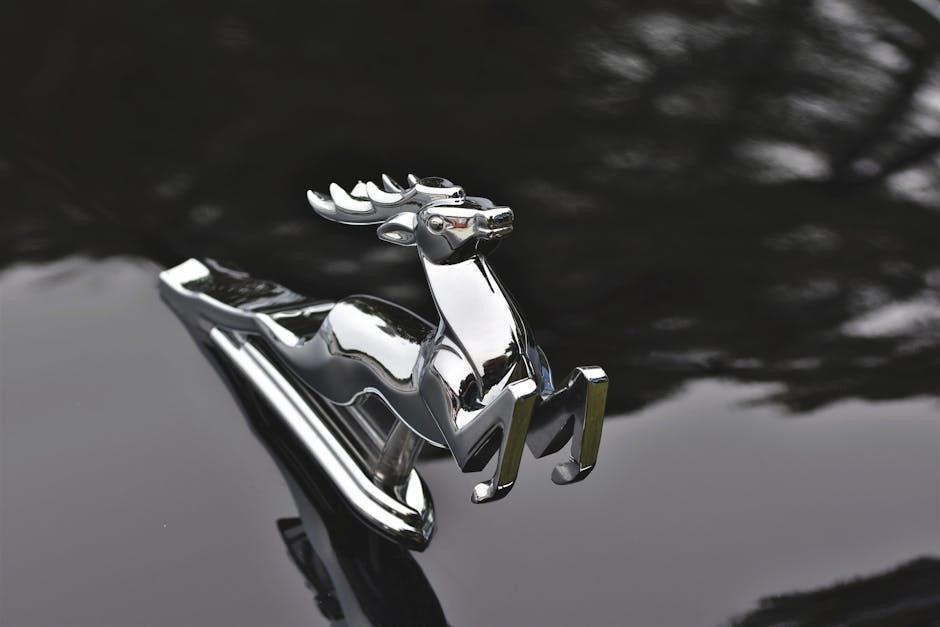A Timer Deer Feeder is an automatic feeding system designed to dispense feed at scheduled times, enhancing deer management and hunting experiences. It offers consistency, efficiency, and convenience for wildlife enthusiasts, ensuring deer are fed regularly without manual intervention. With programmable features, it supports multiple daily feedings, adjustable durations, and compatibility with various feeder types. This innovative tool is ideal for attracting and maintaining healthy deer populations while adhering to legal hunting practices. The feeder is user-friendly, durable, and often comes with a comprehensive manual for easy setup and operation.
1.1 What is a Timer Deer Feeder?
A Timer Deer Feeder is an automated system designed to dispense feed at predetermined times, optimizing deer feeding schedules. It typically consists of a feeder unit, a programmable timer, and a power source, often a battery. The timer allows users to set specific feeding times and durations, ensuring consistent feed distribution. This system is ideal for wildlife management, hunting, and maintaining healthy deer populations. It is durable, easy to install, and compatible with various feeder types, making it a versatile tool for outdoor enthusiasts.
1.2 Benefits of Using a Timer Deer Feeder
Using a Timer Deer Feeder offers numerous advantages, including consistent and automated feeding schedules, which attract deer more effectively. It saves time and effort by eliminating manual feeding, allowing for multiple feedings per day. The system ensures a steady food supply, promoting healthy deer populations and improving hunting success. Its durability and user-friendly design make it a practical solution for wildlife enthusiasts. Additionally, it supports legal hunting practices by adhering to scheduled feeding times, enhancing overall efficiency and convenience for deer management.

Installation and Setup
Install the feeder securely, attach the timer, and connect the wiring. Ensure all components are properly connected and test the feeder to confirm it operates as expected.
2.1 Physical Installation of the Feeder
Mount the feeder on a sturdy platform or tripod, ensuring stability. Attach the legs to the feeder hopper using pre-installed nut-serts for secure fastening. Position the feeder at an appropriate height to prevent tampering and ensure easy access for deer. Follow the manufacturer’s guidelines for leveling and securing the unit. Ensure the feeder is placed in a location that allows for proper feed dispersion and minimizes waste. Always prioritize stability and safety during installation to maintain functionality and longevity of the feeder.
2.2 Attaching the Timer and Battery
Open the timer door and install the battery according to the polarity indicators. Secure the timer unit inside the compartment, ensuring all connections are tight. Attach the wiring harness to the motor and battery terminals, following the provided diagram. For 12V systems, verify the timer is set to the correct voltage to prevent damage. Use the included fuse for protection. Ensure all connections are insulated and protected from moisture to maintain proper function and safety. Refer to the manual for specific wiring instructions to avoid errors during setup.
2.3 Wiring the Feeder and Timer
Connect the wiring harness to the timer and feeder motor, ensuring proper alignment of positive and negative terminals. Verify the timer is set to the correct voltage (6V or 12V) to match your battery. Attach the red wire to the positive terminal and the black wire to the negative. Install the included fuse for protection. Secure all connections with electrical tape or heat shrink tubing to prevent moisture interference. Refer to the manual for specific wiring diagrams to ensure accurate installation and avoid short circuits.

Programming the Timer
Set the clock and adjust feed times using P1, Hr, and Min buttons. Press Run Time to set duration. Test the feeder to ensure proper operation.
3.1 Setting the Clock and Feed Times
To set the clock, press the MODE button until the clock display appears. Use the Hr and Min buttons to adjust the current time. For feed times, press P1 to P6 to select feeding periods. Use the Hr and Min buttons to set the desired feed time, then press Run Time to adjust the duration. Save your settings by pressing MODE. The feeder will now dispense feed at the programmed times, ensuring consistent and automated feeding schedules for deer.
3.2 Adjusting Feed Duration and Frequency
Adjust the feed duration by pressing the Run Time button to set the desired feeding time in seconds. For frequency, press P1 to P6 to select up to six daily feedings. Use the Hr and Min buttons to choose the exact times. The feeder allows flexible scheduling, ensuring consistent feeding patterns. This feature is ideal for attracting deer effectively while maintaining a balanced feeding routine. Adjustments can be made easily to suit different wildlife management needs or seasonal changes.
3.3 Testing the Feeder
To test the feeder, press and hold the TEST button to activate a trial run. Observe the motor operation and ensure feed is dispensed correctly. Verify the run-time seconds match your settings and adjust if necessary. This step ensures the feeder functions as programmed before leaving it unattended. Testing also helps identify any issues with the timer or motor, allowing for immediate troubleshooting. Regular testing maintains reliable performance and ensures consistent feeding schedules for optimal deer management.

Troubleshooting Common Issues
Identify and resolve common problems like low battery voltage, timer malfunctions, or motor issues. Follow diagnostic steps to ensure proper feeder function and address potential system errors effectively.
4.1 Battery and Power Issues
Battery and power issues are common problems with timer deer feeders. Check if the battery voltage is below 9V, as this can cause malfunctions. Ensure connections are clean and secure. If using a 12V battery, verify the timer is set correctly to avoid errors. A weak or dead battery may prevent the feeder from operating. Replace batteries as needed and monitor the charge level to maintain reliable performance. Always refer to the manual for specific voltage requirements and troubleshooting steps to resolve power-related problems efficiently;
4.2 Timer Malfunction and Error Codes
Timer malfunctions can occur due to incorrect voltage settings or internal errors. If the timer vibrates or buzzes, check the battery voltage and connections. Ensure the timer is set to the correct voltage (6V or 12V). Error codes may appear, indicating issues like blown fuses, frozen timers, or motor problems. Resetting the timer or replacing fuses often resolves these issues. If the timer is unresponsive or displays persistent errors, replace it within the warranty period. Always consult the manual for specific error code meanings and troubleshooting steps.
4.3 Motor and Feeding Problems
Motor issues may arise if the feeder is clogged, the battery voltage is low, or there’s mechanical wear. If the motor operates slowly or fails to start, check for blockages and ensure proper assembly. Feeding problems, such as inconsistent dispersal, can result from incorrect feed rate settings or worn-out parts. Test the motor separately and ensure the feeder is clear of debris. If issues persist, refer to the manual for advanced troubleshooting or consider replacing faulty components to restore proper function. Regular maintenance can prevent such problems.
Maintenance and Repair
Regular inspections ensure smooth operation. Clean the feeder and timer periodically, check for wear, and replace batteries and fuses as needed. Refer to the manual for complex repairs.
5.1 Regular Maintenance Checks
Regular inspections are crucial for optimal performance. Check the timer’s battery level and wiring connections. Ensure the feeder’s motor operates smoothly and verify that all scheduled feedings are functioning correctly. Clean the feeder regularly to prevent clogging and mold growth. Inspect the timer display for clarity and responsiveness. Replace worn or damaged parts promptly. Lubricate moving components to reduce wear. Keep the feeder and timer dry to avoid corrosion. These checks ensure reliability and extend the product’s lifespan, maintaining consistent feeding schedules for deer.
5.2 Replacing Batteries and Fuses
Regularly inspect and replace batteries every 1-2 years, depending on usage. Use a 6V or 12V deep-cycle battery for optimal performance. To replace, disconnect the old battery, ensuring the feeder is powered off; Install the new battery securely, matching the correct polarity. For fuses, check for blown indicators and replace with the same amp rating. Always test the feeder after replacements to ensure proper function. Keep spare batteries and fuses on hand for seamless operation and minimal downtime.
5.3 Advanced Repair Techniques
For persistent issues, advanced repair techniques involve inspecting the circuit board for corrosion or damage. Clean connections gently with a soft brush or replace corroded parts. If the motor fails, check for blockages or worn gears. Replace faulty components like relays or sensors. Ensure wiring is secure and free from damage. For complex problems, consult the manual or contact a professional. Always disconnect power before attempting repairs to avoid injury or further damage to the feeder system.

Advanced Features and Customization
Advanced features include scheduling multiple feedings, adjusting feed rates, and utilizing solar panels for efficiency. These options enhance customization, ensuring consistent deer attraction and optimal feeding control.
6.1 Scheduling Multiple Feedings
The Timer Deer Feeder allows users to schedule up to six feedings daily, ensuring consistent and efficient deer feeding. By programming specific times, users can attract deer effectively. The digital timer simplifies setting feed schedules, with options to adjust times and durations as needed. This feature ensures feeding consistency, even when users are not present. Advanced models may offer additional customization, such as variable intervals and feed rates, enhancing the overall feeding strategy for optimal wildlife management and hunting success.
6.2 Adjusting Feed Rates and Times
Adjusting feed rates and times on the Timer Deer Feeder enhances feeding efficiency and customizes the system to specific needs. Users can modify how long the feeder operates during each cycle, typically in seconds, to control feed dispersion. Additionally, feed times can be fine-tuned to align with deer activity patterns, optimizing attractant effectiveness. This feature ensures that feed is distributed precisely when and how it’s needed, supporting healthier deer and better hunting results while minimizing waste and resource use.
6.3 Using Solar Panel Capabilities
The Timer Deer Feeder can be equipped with solar panel capabilities, offering a sustainable and efficient power solution. This feature allows users to harness solar energy, reducing reliance on battery replacements and lowering maintenance costs. Solar panels ensure continuous operation, even in remote locations, and are environmentally friendly. To maximize efficiency, position the solar panel in direct sunlight and follow the manual’s guidelines for installation. This eco-friendly option enhances the feeder’s reliability and performance, making it ideal for long-term use in the field.

Warranty and Support
The Timer Deer Feeder is backed by a five-year warranty, covering defects in materials and workmanship. For assistance, contact customer support at 800-443-4244 or visit www.sweeneyfeeders.com.
7.1 Understanding the Warranty Terms
The Timer Deer Feeder is protected by a five-year limited warranty, covering manufacturing defects in materials and workmanship. The warranty applies to the timer unit and requires proof of purchase. Damage from misuse, improper installation, or natural elements is excluded. Battery and fuse replacements are not covered under warranty. For warranty claims, contact Sweeney Enterprises, Inc., or visit their website for detailed terms and conditions.
7.2 Contacting Customer Support
For assistance with your Timer Deer Feeder, contact Sweeney Enterprises, Inc., at 800-443-4244 or visit their website at www.sweeneyfeeders.com. Customer support is available to address questions, troubleshooting, or warranty claims. Ensure you have your product details and proof of purchase ready. Additionally, refer to the provided manual or online resources for troubleshooting guides before contacting support. For urgent inquiries, email or phone support is recommended for prompt resolution.
7.3 Returning or Replacing the Timer
To return or replace the Timer Deer Feeder, contact Sweeney Enterprises, Inc., within the 5-year warranty period. Ensure the product is returned in original condition with proof of purchase. Replacements are issued for defects like short throws, inoperable buttons, or a frozen timer. For returns, follow the instructions provided by customer support. Shipping costs may apply, and refunds are processed upon inspection. Visit www.sweeneyfeeders.com for detailed return policies and procedures.

Safety and Legal Considerations
Ensure the feeder is installed on a stable platform to prevent accidents. Always comply with local hunting regulations and practice responsible feeding to maintain a healthy deer population and ecosystem balance.
8.1 Safety Precautions for Installation and Use
Always install the feeder on a stable platform to avoid accidents. Wear protective gloves and eyewear during setup. Keep children and pets away from the feeder. Ensure proper wiring to prevent electrical hazards. Regularly inspect the feeder for damage or wear. Follow local regulations regarding feeder placement and use. Avoid installing near overhanging branches or power lines. Keep the feeding area clean to prevent disease spread. Never overload the feeder beyond its recommended capacity.
8.2 Compliance with Local Hunting Regulations
Ensure your timer deer feeder operation complies with local hunting and wildlife regulations. Check feeding restrictions, such as banned times or locations, to avoid legal issues. Some areas prohibit feeding deer during certain seasons or require specific permits. Set your feeder schedule to align with legal feeding hours. Avoid overfeeding, as this can harm deer health and violate regulations. Consult local wildlife agencies for guidance to ensure responsible and lawful use of your timer deer feeder.
8.3 Best Practices for Feeding Deer
For optimal deer feeding, maintain a consistent schedule using your timer deer feeder. Set feeding times at sunrise and sunset when deer are most active. Use high-quality, nutrient-rich feed to promote healthy deer growth. Position the feeder in a secluded, accessible area to avoid over-concentration of deer. Regularly clean and maintain the feeder to prevent spoilage and ensure proper function. Avoid overfeeding, as it can stress deer and disrupt natural foraging habits. Monitor feed levels to sustain a balanced diet without over-reliance on the feeder.
The Timer Deer Feeder is an efficient, reliable, and innovative solution for managing deer feeding schedules. Its programmable features, durability, and ease of use make it an excellent choice for attracting and maintaining healthy deer populations while adhering to ethical hunting practices.
9.1 Summary of Key Features
The Timer Deer Feeder offers programmable scheduling for up to six feedings daily, adjustable feed duration, and compatibility with 6V or 12V systems. It features a digital clock, battery-level indicator, and fuse protection. The feeder is easy to install with a four-wire hookup and includes a wiring harness. Durable construction ensures longevity, while the five-year warranty provides peace of mind. These features make it a versatile and reliable choice for effective deer management and hunting.
9.2 Final Tips for Effective Use
For optimal performance, regularly check the feeder’s battery level and replace it as needed to avoid interruptions. Program feed times according to deer activity patterns, ensuring consistency. Test the feeder after programming to confirm proper operation. Keep the unit clean and protected from harsh weather conditions. Refer to the manual for troubleshooting common issues and maintenance tips. By following these guidelines, you can maximize the feeder’s efficiency and enjoy a successful deer management or hunting experience.

Additional Resources
Visit Sweeney Feeders for detailed manuals and troubleshooting guides. Join deer feeding forums for tips and advice. Contact customer support at info@sweeneyfeeders.com for further assistance.
10.1 Recommended Reading and Manuals
Refer to the official Sweeney Feeders manual for comprehensive setup and troubleshooting guides. The AFT-DFT3 manual provides detailed instructions for programming and maintenance. For Moultrie feeders, consult the Moultrie MFG-13265 manual. These resources offer step-by-step guidance for optimizing your timer deer feeder’s performance and addressing common issues. Visit manufacturer websites for the latest updates and additional support materials to ensure your feeder operates efficiently and effectively.
10.2 Online Communities and Forums
Join online forums like DeerHunterForum.com or HuntingForum.net to connect with hunters and wildlife enthusiasts. These platforms offer discussions on optimizing timer deer feeders, troubleshooting, and sharing tips. Users often exchange advice on programming, maintenance, and deer management strategies. Engage with experienced users to gain insights, solve issues, and enhance your feeding system’s performance. These communities provide valuable peer support and real-world solutions to maximize your timer deer feeder’s effectiveness.
10.3 Contact Information for Further Assistance
For additional support, contact Sweeney Enterprises at www.sweeneyfeeders.com or call their customer service at 800-443-4244. Their team offers expert guidance on timer deer feeder setup, troubleshooting, and maintenance. Visit their website for detailed manuals, FAQs, and repair services. You can also reach out via email at info@sweeneyfeeders.com for personalized assistance. Their comprehensive support ensures optimal performance and longevity of your timer deer feeder.
